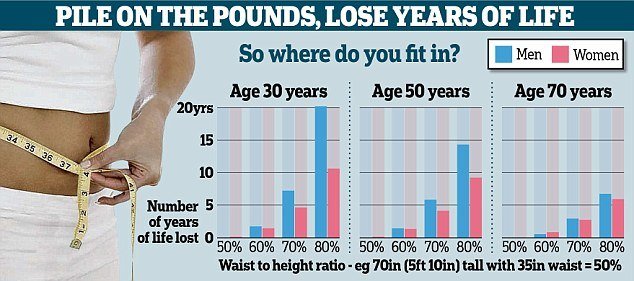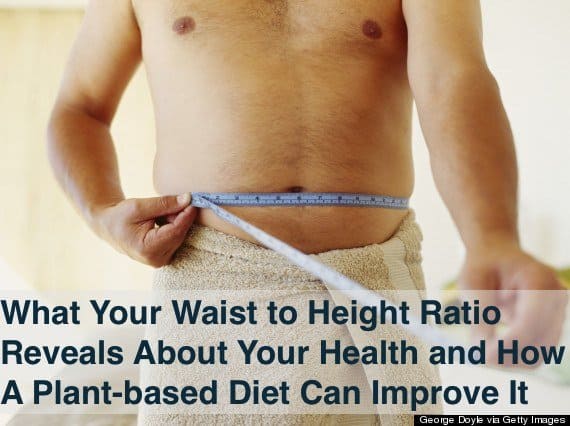What Your Waist to Height Ratio Reveals About Your Health and How A Plant-based Diet Can Improve It
You’ve heard of BMI, yes? Although it’s the standard measurement of body composition, it’s near worthless. What you need to know is your Waist to Height Ratio. Learn why it’s such a valuable indicator and predictor of your health and lifespan, how to measure it, and what to do if your ratio is below “2”.
In his article, The single best type of diet for overall health, according to nutritionists, Science Reporter Erin Brodwin tells us that:
Several recent studies suggest that whether you’re looking for weight loss or to improve your overall health, the best eating plans are based around vegetables, whole grains, and lean proteins.
Mr. Browdin goes on to report that in a report on the best eating plans, US News and World Report described vegetable-based (“plant-based”) diets as “good for the environment, your heart, your weight, and your overall health.” The Mediterranean diet, for example, is focused on whole grains and vegetables, but also includes a variety of healthy fats, like those from nuts, fish, avocados, and olive oil.
Dr. Michael Greger, perhaps the world’s most recognized nutritionist, agrees. The following assertions and videos come from Dr. Greger. They all deal with the value of eating more plants in your diet, except for the part about WHR, “Waist to Height Ratio”.
WHR is about the quickest, surest way to get a sense for your current and projected health. You just need a tape measure. If you’re unhappy with the result, make sure you watch the rest of the videos to learn how to make it better.
The reason I’m combing information about the Waist to Height Ratio and a plant-based diet is that it’s likely that your WHR will be too high, and the way to get it lower is to eat more plants, such as whole fruits and vegetables.
That’s not to say that you need to stop eating meat (although I would recommend you consume less of it and make sure it’s very high quality), but that you add plant-based foods to your diet.
As you’ll soon see, the science if very clear on this.
So, as long as you’re here, here’s what to do:
- First, read about the Waist to Height Ratio measurement and why it’s predictive of health; then watch the video.
- Second, measure and calculate your Waist to Height Ratio.
- Third, after you faint, pick yourself off the floor and read about how to get trim by adding plants to your diet; and watch the videos.
- Fourth, read the “Your Takeaway” section, because there are links to more suggestions on how to get lean.
Let’s get cracking…
Your Waist to Height Ratio is Your Surest, Quickest Indicator of Health
BMI is the standard method for indicating body composition in terms of weight, but as I wrote here, BMI can be worthless in some cases, and even if it accurately categorizes your body composition, it indicates little about your health.
Fortunately, we have WHR.
What in the heck am I taking about?
Well, BMI (Body Mass Index) is the standard measurement used to assess body weight in terms of these categorizations: Underweight, Normal, Over Weight, Obese. BMI uses a formula with just two inputs: height and weight.
Despite being pretty lean, my BMI puts me in the Over Weight category. The reason is that I have more muscle than the average guy my height. If you’re very short, very tall, more or less muscular than average, BMI will not provide an accurate assessment.
Could be, then, that BMI will not truly indicate whether you’re overweight or not. More importantly, it can not indicate what’s most important — where your extra weight accumulates on your body!
So, forget BMI; instead, know your WHR!
As you know by know, the WHR is “Waist to Height Ratio.” It takes into account that health risks can be determined as much by the relative distribution of the excess fat, as by its total amount:
It’s not so much overall body fat itself, but visceral body fat, abdominal fat, the fat around our internal organs, that most increases our risk of dying prematurely, says studies cited in Waist Circumference Less Than Half Your Height.
These bar charts tell the tale:
 (source)
(source)
The data above come from a review of a study by scientists at City University London. Their three big conclusions:
- Your waistline should be no more than half your height
- New report shows people adding inches on the waists could die early
- A 30-year-old man standing at 5ft 10in with a 56in waist could lose 20.2 years
As long as your Weight to Height Ratio is half your height or less, you should live to the average life expectancy – which is currently around 81, says Dr. Margaret Ashwell, the lead scientist of the study. But for every few inches over, you face losing months or even years of life.
For example, an average 30-year-old man who is 5ft 10in tall – or 70 inches – should have a waist size no bigger than 35 inches. A 30-year-old 5ft 4in woman should have a waist size of 32 inches or under.
But if the man’s waist size expands to 42 inches – or 60 per cent of his height – it will knock 1.7 years off his life, according to the formula. Likewise if the woman’s waist grows to 38.4 inches she will lose 1.4 years.
Here’s how you measure WHR:
Use a cloth measuring tape, and measure halfway between the top of your hip bones, and the bottom of your rib cage (which for me is just over my belly button). Stand up straight, breathe in deeply, exhale, relax (don’t suck in your waist) and then see what the tape measure tells you.
The aim is for your WHR to be half your height; ideally less.
Let’s use my stats as an example. I’m 75.5 inches tall and my waist circumference is 36.5 inches:
75.5 height /36.5 waist = 2.07
(Or as Dr. Ashwell of the City University London calculates it (waist/height), my WHR would be 0.48, which puts my waist at just under 1/2 my height.)
I surely wouldn’t mind having a little less jiggly around my midsection, but since I’m twice as tall as my waist circumference, my WHR indicates that I do not have an unhealthy fat distribution; whereas my BMI of 25.4 puts me in the “Overweight” category.
(Read my article, Just Exactly How Fat Are You Anyway? where you’ll find a BMI Calculator.)
All the women in the picture below have the same BMI, but those who are “apple-shaped” are likely to have the worst health outcomes. And that’s true for men as well.
Thus the value of the WHR measurement, which has become a screening tool for predicting cardiovascular disease and diabetes. Watch Dr. Greger’s video below to learn more about it:
(source)
What should you do if your WHR is below 2?
Keep reading, because I’m going to show you how adding plants (whole fruits, veggies and the like) can help you whittle away the fat from your midsection and everywhere else.
Eat More, Weigh Less
Yes, it can happen due to a relatively new concept referred to as “Energy Density”.
When it comes to a food’s or drink’s Energy Density, the lower the better.
Energy Density is the amount of calories per unit weight of a food or beverage. Foods high in water and fiber content are generally lower in energy density. On the other hand, because dietary fat provides the greatest amount of calories per unit weight, foods high in fat are generally high in energy density.
Notwithstanding nutritional attributes, other examples:
- High density — bacon
- Medium density — bagel
- Low density — fruits and veggies (note that they both contain water and fiber)
In general, the lower is the energy density the better, with two exceptions:
- Soda is so heavy that by energy density it looks less harmful than it is.
- Nuts have so much fat, they appear less healthy than they are.
How can you benefit from this information?
People tend to eat a consistent weight of food, so when there’s less calories per pound, caloric intake is reduced. A small drop in energy density can lead to a small drop in weight, and the greater the decrease in energy density, the greater the weight loss.
Reduce your energy density by:
- Adding fruits, veggies, plants and starch-filled roots (like sweet potatoes) to your meals can help you lose weight even if you do not change anything else in your diet.
- Lowering the fat and sugar content of your meals.
Researchers tried this in Hawaii. They had people eat all the plant food they could eat. Result:
- They lost an average of 17 pounds in just 21 days, resulting in better cholesterol, triglycerides, blood sugars, and blood pressure.
- Caloric intake dropped 40%, but not by eating less food; in fact, they lost 17 pounds in 21 days eating more food, four pounds of food per day.
These Hawaiian results are typical. In Nutrient-Dense Approach To Weight Management, Dr. Greger cites a study that analyzed the diets of 13,000 people and comparde the nutrient intake of those eating meat to those eating meat-free diets.
The findings:
- The plant-based diet provided more fiber, vitamin A, vitamin C, vitamin E, the B vitamins (thiamin, riboflavin, & folate), calcium, magnesium, iron, and potassium.
- The plant-based diet provided less saturated fat and cholesterol.
- It provided sufficient protein.
- Those in the study consumed 363 fewer calories per day, without limiting food intake.
- They had an 11% higher resting metabolic rate than their meat-eating brethren.
Watch the video:
(source)
Don’t confuse “energy dense” with “nutrition dense”, which is where a plant-based diet shines, as this video will show you given recent studies on the matter:
(source)
What Diet Should Your Doctor Recommend?
Kaiser Permanente has an answer.
It’s the largest managed-care organization in the United States, which covers about nine million people with about 15,000 physicians. In its 2013 Nutritional Update for Physicians, Kaiser said:
Healthy eating may be best achieved with a plant-based diet…defined as a regimen that encourages whole, plant-based foods and discourages meat, dairy, eggs as well as all refined and processed foods.
Kaiser teases that side effects may include:
- Lower cholesterol
- Lower blood pressure
- Lower blood sugar
- lower risk of cancer
- Lower risk of diabetes
- Reversal or prevention of heart disease
- A longer life
- Will improve inflammatory conditions, like “rheumatoid arthritis
- May slow the progression of certain types of cancer
Watch this video to get the whole story:
Your Takeaway
If you remember just one idea, let it be from this much-quoted quip of author and nutritionist Michael Pollan:
Eat food. Not too much. Mostly plants.
(By the way, “food” refers to real food, not processed food.)
If you’re brain is working well today, here’s two more things to remember and consider:
- If you can’t adjust your diet, just add whole fruits (not fruit juice) and vegetables. If you don’t know how to prepare plant based food, simply blend them up with some protein powder (try pea, hemp, rice protein), almond milk and water.
- If you want to get a Waist to Height Ratio of “2” or more, read my article 8 Sure-fired Ways To Trim Body Fat and Keep It Off Forever, plus dig into some of these exercises.
P.S. Want to know more about a plant-based diet? Read Eat Like A Gorilla. 
Last Updated on March 12, 2022 by Joe Garma




